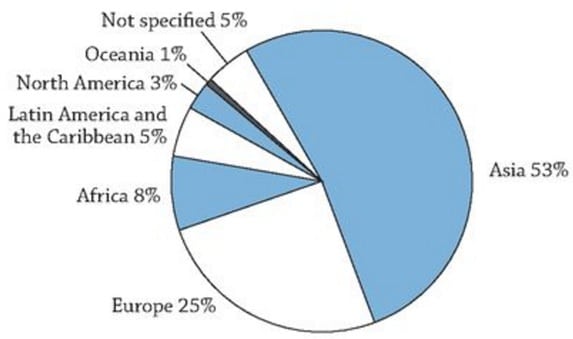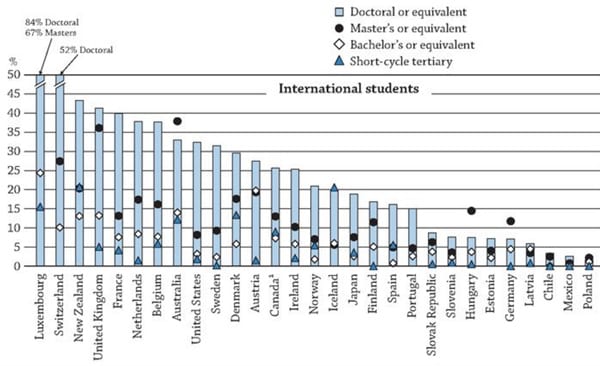New OECD report summarises global mobility trends
The Organisation for Economic Co-operation and Development (OECD) released its annual report on global education trends last week. Education at a Glance 2015 draws on a wealth of data to map educational attainment, participation rates, outcomes from education, and other key indicators for countries around the world. Our focus today is on its findings with respect to international mobility. Drawing largely on data through the 2012/13 academic year, Education at a Glance 2015 reaffirms many of the key characteristics of international mobility that we have come to understand over the past decade.
Ongoing rise in international student mobility
The number of foreign tertiary students enrolled worldwide increased by 50% between 2005 and 2012. As many as 4.5 million students were enrolled outside of their home countries in 2012 and the total number is estimated to have surpassed five million by this year. The report notes, "Student mobility has increased dramatically over the recent past, due to a range of factors. The exploding demand for tertiary education worldwide and the perceived value of studying at prestigious post-secondary institutions abroad contribute to an increasing and diversified flow of international students, ranging from those who cannot find a place to study in post-secondary education at home to students of high academic achievement studying at high-quality programmes and institutions. In addition, the educational value associated with a diverse student body, the substantial revenues that can be earned by expanding education for international students, and economic and political considerations prompted some governments and institutions to make major efforts to attract students from outside their national borders."
Asia is the engine of growth in global student mobility
It was the region of origin for 53% of all international students in 2012/13, and China and India remain the world’s first and second-largest source markets. "Asia is dominating," said Andreas Schleicher, Director of the OECD Directorate for Education and Skills.
“That is where you can see the hunger for learning. Parents want their children to get a better education and they still quite often choose countries in the Western world, in OECD countries, to obtain those qualifications.
It may change in the future but at the moment that is still by a large margin the most dominant source of international students, followed by Europe, and with a large gap by Africa."

Shifting market share
The US remains the leading study destination but, while absolute numbers of foreign students in America continue to increase, its market share has fallen. "That share is declining in the United States," adds Mr Schleicher. "The market is dividing up quite differently with countries like Japan [and some European countries] getting a larger share."
More broadly, Australia, Canada, France, Germany, Japan, and the United Kingdom together receive more than 50% of all international students worldwide and OECD countries attract 73% of all students enrolled abroad.
Also of note: the number of international students enrolled in tertiary education in OECD countries was, on average, three times the number of students from OECD countries studying abroad.
Level of study variations for international students
Education at a Glance 2015has some thought-provoking new observations as well. In particular, it highlights the growing importance of post-graduate programmes and the higher proportions of international student enrolment at advanced levels of study. "The proportion of international students among total higher education enrolments tends to be much larger at the most advanced levels of tertiary education," notes the report. "On average across OECD countries, 24% of students enrolled in doctoral or equivalent programmes are international students against an average of 9% in all levels of tertiary education." The OECD speculates that the following factors may be contributing to greater proportions of internationally mobile students in advanced studies:
- Particularly severe capacity constraints - that is, very limited opportunities for post-graduate or doctoral studies - in the students’ countries of origin;
- The benefits of study abroad, in terms of career opportunities and earning potential, are that much greater at advanced levels of study;
- Doctoral (or comparable level) students may simply be more likely to travel and live abroad, in part because they would be attractive to their host countries for their research contributions during their studies and/or as highly qualified immigrants.
The following chart makes the point quite vividly that while foreign students may represent a relatively small proportion of total undergraduate enrolment in a major destination like the US, their participation rates are much higher at the master’s and doctoral levels.

Hit the brakes?
The report also gives passing attention to a possibility that has begun to play on the minds of international educators in recent years: can the market keep growing as quickly as it has? More to the point, what happens if growth slows significantly? There are a variety of inter-related demand factors that influence demand patterns for study abroad, including domestic capacity, economics, demographics, labour market requirements, and immigration policies. And on the question of future trends, OECD says only, "In the current economic climate, shrinking support for scholarships and grants, as well as tighter budgets for individuals, may slow the pace of student mobility." The report does go on, however, to explore the different elements that drive student decision-making around study abroad and it distills these down to the following decision factors:
- Language of instruction. Languages that are widely spoken and read are attractive and the "progressive adoption of English as a global language" remains a major factor in the prominence of English-speaking destinations. This underlying demand driver has also played an important part in the expansion of English-taught programmes in non-English-speaking destinations, including those in Europe.
- Quality of programmes. Study destination attractiveness correlates strongly to perceptions of quality, as derived from international university rankings but also from a wide range of other indicators of quality for individual institutions and programmes.
- Costs of study. Both tuition and costs of living factor here, and all are filtered through the lens of prevailing currency exchange rates. OECD notes cost as an important consideration but observes as well that higher tuition fees do not necessarily discourage prospective students so long as the quality of education is perceived to be high.
- Immigration policy. There is no question that the destination country’s policies around student immigration are one of the most important determinants of attractiveness for foreign students. This pertains to the ease (and timeliness) with which a student visa can be obtained but also to opportunities for the student to work during or after his or her studies. The prospects for immigration after graduation may also be an important factor for students and host countries alike.
The global classroom
Overall, the OECD’s findings for 2015 reflect a global marketplace for education that continues to expand, but that is also increasingly complex. "Tertiary education is becoming more international through a number of means," notes the report. "For example distance education, international education-related internships and training experiences, crossborder delivery of academic programmes, and offshore satellite campuses." The global education market is also characterised of late by more varied patterns of mobility. China, for example, remains the world’s leading source of mobile students but is now also an important study destination in its own right. The same is true for Malaysia and a number of other regional destinations around the globe. Growth rates and other high-level market trends will continue to hold our attention in 2016. But this expanding range of shifting market conditions will also challenge and engage international educators in the years ahead.
Most Recent
-
United States: Government enforcement action on schools, universities, and international students intensifies Read More
-
UK commission calls for a more strategic and sustainable approach to international student recruitment Read More
-
Study shows that international educators and students want to lessen carbon footprint but that barriers remain Read More















